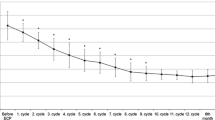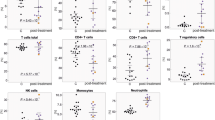Abstract
In the study, we investigated the influence of extracorporeal photochemotherapy (ECP) on lymphocyte activation and cell death by determining CD95, Annexin V, CD69 and human leukocyte antigen (HLA)-DR expression on circulating T and B cells in systemic sclerosis (SSc) patients and assessed their changes after ECP therapies. Moreover, we evaluated the relationship between lymphocyte activation and the observed changes in immunoregulatory functions following ECP treatments. We enrolled 19 SSc patients, who received 12 ECP treatments in total. Blood samples were taken prior to the first therapy and 6 weeks after each cycle. Samples were also obtained from 16 healthy controls. Lymphocyte subgroups were quantified by flow cytometry. Initially, patients had higher numbers and percentages of peripheral CD95+ T cells, but not CD95+ B cells, compared to control values. After ECP treatments, values of CD95+ T cells decreased and became similar to controls. Annexin V expression on T and B cells did not change during the therapy. We observed a significant negative correlation between the changes in percentages of peripheral CD95+ T cells and CD4+CD25+ Treg cells. Although neither early-activated (CD69+) nor late-activated (HLA-DR+) T lymphocytes showed significant changes after ECP, clear negative correlations developed between them and the functional ability of CD4+CD25+ Treg cells after the last treatment. Our results indicate that the initial increase of CD95+ expression in SSc presumably reflects a physiological response to the pronounced autoimmune processes, which can be effectively attenuated by the restoration of regulative T cell numbers and functions as the result of ECP therapy.




Similar content being viewed by others
References
LeRoy EC, Medsger TA Jr (2001) Criteria for the classification of early systemic sclerosis. J Rheumatol 28:1573–1576
Papp G, Horvath IF, Barath S, Gyimesi E, Sipka S, Szodoray P, Zeher M (2011) Altered T-cell and regulatory cell repertoire in patients with diffuse cutaneous systemic sclerosis. Scand J Rheumatol 40:205–210
Szodoray P, Papp G, Nakken B, Harangi M, Zeher M (2010) The molecular and clinical rationale of extracorporeal photochemotherapy in autoimmune diseases, malignancies and transplantation. Autoimmun Rev 9:459–464
Bladon J, Taylor PC (2006) Extracorporeal photopheresis: a focus on apoptosis and cytokines. J Dermatol Sci 43:85–94
Enk AH (2005) Dendritic cells in tolerance induction. Immunol Lett 99:8–11
Papp G, Horvath IF, Barath S, Gyimesi E, Vegh J, Szodoray P, Zeher M (2012) Immunomodulatory effects of extracorporeal photochemotherapy in systemic sclerosis. Clin Immunol 142:150–159
LeRoy EC, Black C, Fleischmajer R, Jablonska S, Krieg T, Medsger TA Jr, Rowell N, Wollheim F (1988) Scleroderma (systemic sclerosis): classification, subsets and pathogenesis. J Rheumatol 15:202–205
Szodoray P, Gal I, Barath S, Aleksza M, Horvath IF, Gergely P Jr, Szegedi G, Nakken B, Zeher M (2008) Immunological alterations in newly diagnosed primary Sjögren's syndrome characterized by skewed peripheral T-cell subsets and inflammatory cytokines. Scand J Rheumatol 37:205–212
Kessel A, Rosner I, Rozenbaum M, Zisman D, Sagiv A, Shmuel Z, Sabo E, Toubi E (2004) Increased CD8+ T cell apoptosis in scleroderma is associated with low levels of NF-kappa B. J Clin Immunol 24:30–36
Stummvoll GH, Aringer M, Smolen JS, Köller M, Kiener HP, Steiner CW, Bohle B, Knobler R, Graninger WB (2000) Derangement of apoptosis-related lymphocyte homeostasis in systemic sclerosis. Rheumatology (Oxford) 39:1341–1350
Paulsen M, Janssen O (2011) Pro- and anti-apoptotic CD95 signaling in T cells. Cell Commun Signal 9:7
Martin SJ, Reutelingsperger CP, McGahon AJ, Rader JA, van Schie RC, LaFace DM, Green DR (1995) Early redistribution of plasma membrane phosphatidylserine is a general feature of apoptosis regardless of the initiating stimulus: inhibition by overexpression of Bcl-2 and Abl. J Exp Med 182:1545–1556
Acknowledgments
This work was supported by the TÁMOP 4.2.1./B-09/1/KONV-2010-0007 project. The project is co-financed by the European Union and the European Social Fund.
Disclosures
None.
Author information
Authors and Affiliations
Corresponding author
Electronic supplementary material
Below is the link to the electronic supplementary material.
ESM 1
(JPEG 68 kb)
Rights and permissions
About this article
Cite this article
Papp, G., Barath, S., Szegedi, A. et al. The effects of extracorporeal photochemotherapy on T cell activation and regulatory mechanisms in patients with systemic sclerosis. Clin Rheumatol 31, 1293–1299 (2012). https://doi.org/10.1007/s10067-012-2000-x
Received:
Revised:
Accepted:
Published:
Issue Date:
DOI: https://doi.org/10.1007/s10067-012-2000-x




